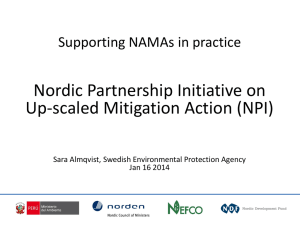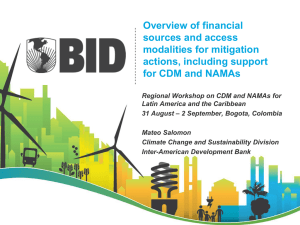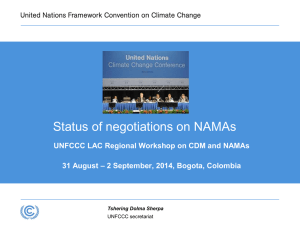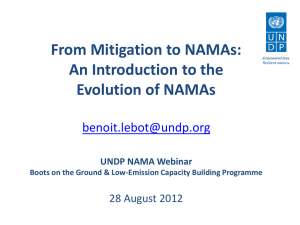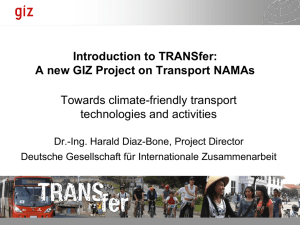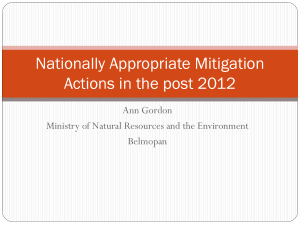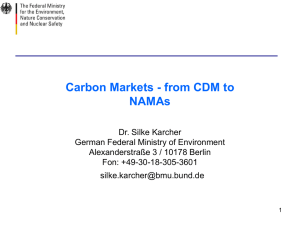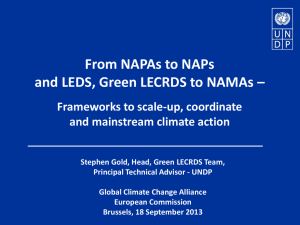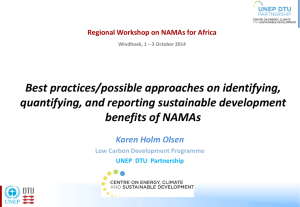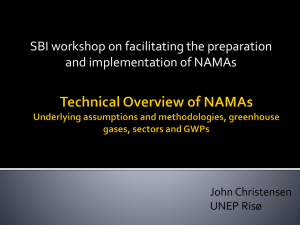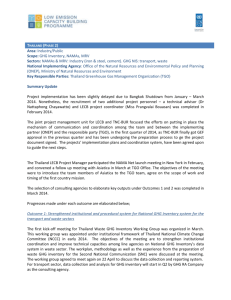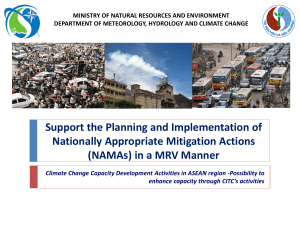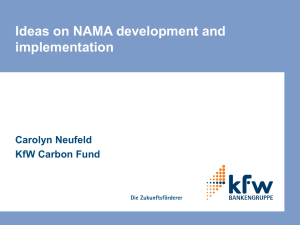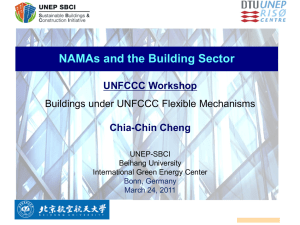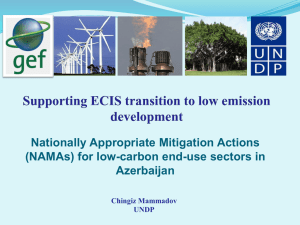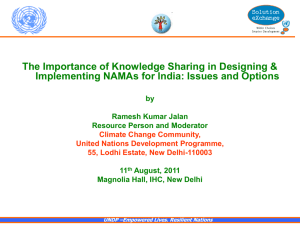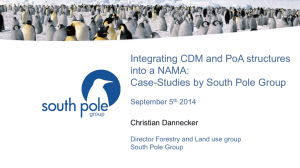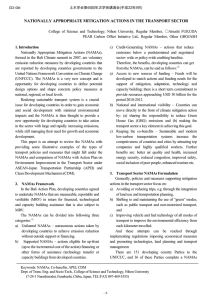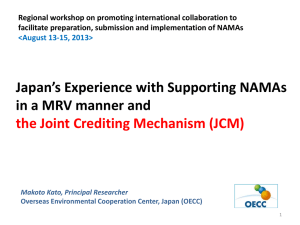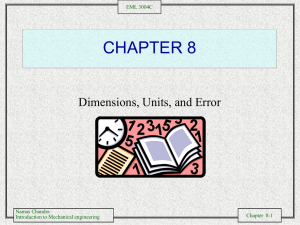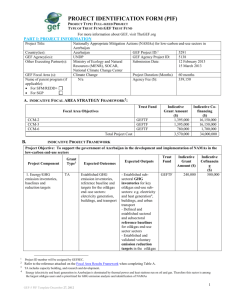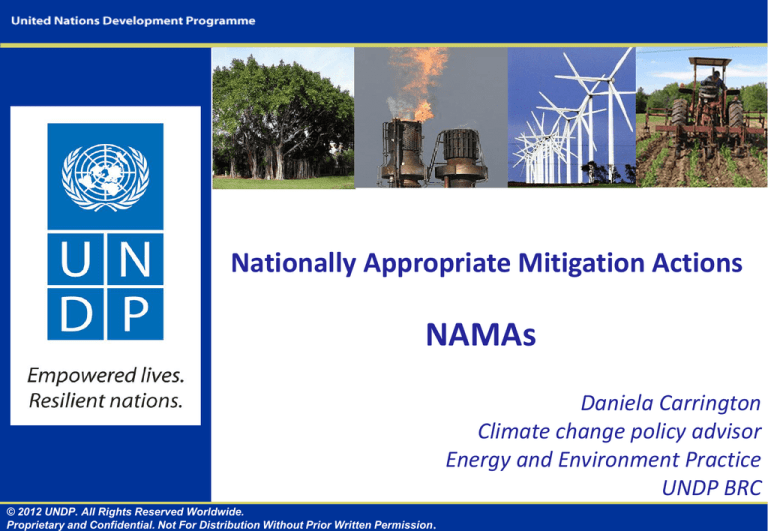
Nationally Appropriate Mitigation Actions
NAMAs
Daniela Carrington
Climate change policy advisor
Energy and Environment Practice
UNDP BRC
© 2012 UNDP. All Rights Reserved Worldwide.
Proprietary and Confidential. Not For Distribution Without Prior Written Permission.
Charting a course away from dangerous climate change:
A window of opportunity of 100 months
•
To keep within 2C threshold CO2eqv concentration
should stabilize at 450 ppm
•
A sustainable emissions pathway will require the
world to cut of 50 percent by 2050
World population predicted to reach
nearly 9 billion by 2050
Entering into new era of green global
economic growth, through significant
mitigation of GHG emissions and generating
funding for mitigation and adaptation
actions and thus creating new investment
opportunities
We
have
witnessed
three
economic
transformations in the past century. First came
the industrial revolution, then the technology
revolution, then our modern era of globalization.
We stand at the threshold of another great
change: the age of green economics.”
UN Secretary General, Ban Ki-moon
2
UNFCCC on NAMAs
• Agreed in Bali in 2007 (COP13), submissions after Cancun 2010
(COP16) and elaborated at subsequent sessions:
– Voluntary mitigation actions by developing countries – domestically implemented or
internationally supported in the context of sustainable development
– Any government-supported (prioritized under LEDS) policy, program, project that
results in measurable GHG reductions can be a NAMA
• Developments on:
– MRV: domestic and international, biennial update reports, ICA
– NAMA Registry: will record information and facilitate the matching of action and
support (operational after Doha)
– Financing: Green Climate Fund to support development and implementation (fast
start finance and after it?)
3
Formats for NAMA
The Durban Agreements (2011) provide general framework of information that should
be provided for NAMAs seeking international support via the NAMA registry:
(a) Description of the mitigation action and the national implementing entity, including contact
info;
(b) Expected timeframe for the implementation of the mitigation action;
(c) Estimated full cost of the preparation;
(d) Estimated full cost and/or incremental cost of implementation of the mitigation action;
(e) Amount and type of support (financial, technological and capacity building) required to
prepare and/or implement the mitigation action;
(f) Estimated emission reductions;
(g) Other indicators of implementation;
(h) Other relevant information, including the co-benefits for local sustainable development, if
information thereon exists.
UNFCCC Registry: http://unfccc.int/cooperation_support/nama/items/6945.php
UNEP: NAMA Idea Note (NINO) (similar to PIN for the CDM)
http://namapipeline.org/Publications/LowCarbonDevelopmentStrategies_NAMAprimer.pdf
4
Current developments at Bangkok informal meeting
Proposed elements for Doha decision (not agreed):
•
To reiterate invitation to developing countries to submit NAMAs
•
Continue the process of understanding the diversity of NAMAs
•
To submit additional information on underlying assumptions,
methodologies, sectors, gases, GWP, support needed
•
Compile information on NAMAs in a structured manner
•
Request the relevant body to develop MRV guidance for support
•
Work to clarify methodological issues, taking into account national
diversity
•
Organize regional workshops to build capacity
•
Take stock of existing capacity building activities to support NAMAs
development and implementation
•
Prepare a handbook to support preparation of NAMAs
5
UNFCCC workshop on NAMAs, Bangkok
In session workshop on NAMAs (2 September 2012)
Panel 1. Underlying assumptions and methodologies, sectors and gases , and
estimated mitigation:
Developing countries - instruments for transparency have been developed already
(i.e., ICA and biennial update reports) so no need for additional processes on
reporting and transparency; NAMAs are country-driven, diverse and must
respect national circumstances; there is no need for their standardization
Developed countries - value of increased transparency on NAMAs by expressing
the underlying assumptions, such as GDP growth and baseline emissions
Panel 2. Support for NAMAs:
EU - need for countries to contribute their own finance; NAMAs should fit
within country’s broader LEDS. Operationalization of support through the
UNFCCC Registry early next year
Developing countries - need for all kind of capacity needs in regards to NAMA
development, implementation, and MRV
Informal summary: http://unfccc.int/files/adaptation/application/pdf/wsnamasummary4sep12.pdf
6
Thank you!
daniela.stoycheva@undp.org
7
UNDP tools
http://www.undp.org/content/undp/en/home/librarypage/environ
ment-energy/low_emission_climateresilientdevelopment.html#
8
Supporting the EE and CIS transition to low-emission
development: Governments to have an enhanced capacity to design,
access finance and implement LEDS/NAMAs
Regional
Project
The countries
will be enabled to make informed
policy and investment decisions, that reduce GHG
emissions,
reduce
poverty,
create
new
employment opportunities and green jobs and
move societies towards long term sustainability.
Developed:
• How
to Guide on Low-emission development strategies and
Nationally Appropriate Mitigation Actions: Eastern Europe
and CIS – in English and Russian (other UNDP tools)
• LEDS/Plans
in
Kazakhstan,
Moldova,
Turkey,
Turkmenistan, Uzbekistan, initiated in BiH and Croatia
http://europeandcis.undp.org/home/publications/
9
NAMA Idea Note _ UNEP
10
How to organize NAMA development
• The linkages to national communications and GHG inventories, as
well as the data needed for designing a NAMA
• Integration of NAMAs into broader low-carbon (SD) development,
• Setting up a interministerial coordination and assure stakeholders
involvement for identifying and prioritizing (criteria/political) NAMAs
and
• Identification of sources
of finance, technology and c.b.
needs
• The MRV systems
• Roles and responsibilities of different ministries and institutions in
developing, submitting, implementing, and MRVing (double
counting)
11

